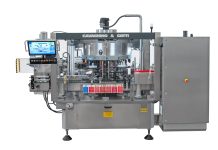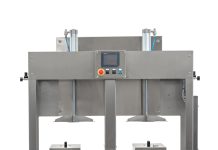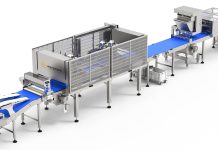Industrial implementation of processes for the recovery of high added-value compounds from food by-products.
Despite huge efforts in the field, the products derived from food by-products remain still rather limited. In a recent investigation, only 35 companies with related products were identified around the world, whereas many of them have not been fully commercialized yet or are in an early stage of development. These products include proteins from whey, dietary fibers from vegetable waste, polyphenols from olive mill wastewater (at least 5 companies for each application), fish oil from fishery by-products (at least 3 companies), lycopene from tomato waste (at least 2 companies), keratin from chicken feathers, sugar and flavonoids syrup from citrus peel, polyphenols from pine bark, anthocyanins from grape pomace, proanthocyanidins and oil from grape seeds, protein from meat processing by-products and fish skin, yeast extract and lactic acid from sugar beet pulp, polysaccharides from coffee waste and brewers spent grain, albumin from soy protein isolate wastewater, and chitosan from shrimp shells (at least 1 company for each application) (Galanakis & Schieber, 2014; Galanakis et al., 2015). Red grapes and wine are among the foodstuff that contain an appreciable amount of phenolics, such as low molecular weight (0.15-0.35 kDa) acids, hydrolysable tannins (gallotannins, ellagitannins), flavonols (catechins and proanthocyanidins) and anthocyanins. Due to their increased antiradical and reducing power, these compounds can be used either as nutritional supplements or food natural preservatives. Winery sludge (WS), the solid waste generated during wine decanting, also contains a notable concentration of phenolic compounds, ranging from 1.2 to 19.0 g·kg-1 and therefore it could be considered as a potential under-valued source of bioactive compounds (Galanakis et al., 2013).
The “Universal Recovery Strategy” and the “5-Stages Universal Recovery Process”
The extraction, fractionation and isolation of high added-value compounds from food wastes usually follow the principles of analytical chemistry. Thereafter, modifications are accordingly introduced into the applied methodology with an ultimate goal of:
- maximizing the yield of the target compounds,
- suiting the demands of industrial processing,
- clarifying the high added-value ingredients from impurities and toxic compounds, and
- avoiding deterioration and loss of functionality during processing and ensuring the food grade nature of the final product.
The recovery of any target compound from food by-products can be accomplished in five distinct stages that follow the principles of analytical chemistry. These include: (a) macroscopic pre-treatment, (b) separation of high-molecular from low-molecular compounds, (c) extraction, (d) purification/isolation and (e) encapsulation or product formation. This downstream scheme (so-called “5-Stages Universal Recovery Process“) is typically selected if two different ingredients are recovered or the valuable component is a micromolecule (i.e. antioxidant). In reverse, when the target compound is a macromolecule (i.e. protein), the second stage may be omitted. For each recapture step, conventional processing techniques like membrane separation, alcohol precipitation, solvent extraction and others have been developed (Galanakis, 2012). Non-thermal emerging technologies (i.e., high voltage electrical discharges, ultrasound, or pulsed electric field) have recently been proposed to shorten the processing time, increase recovery yield, control the Maillard reactions, improve the product quality, and enhance functionality of extracts (Galanakis, 2013). More recently, a “Universal Recovery Strategy” was developed to provide a holistic approach in the field of nutraceuticals recovery, taking into account all the necessary information (e.g. variation of initial source content, appropriate steps and technologies etc) needed for this process (Galanakis, 2015b).
Objectives
Ultrafiltration (UF), nanofiltration (NF) and other membrane technologies are among the key physicochemical and non-destructive techniques applied in the second, third and fourth step of the above downstream processing (Galanakis, 2015a). Particularly, researchers target to concentrate macromolecules and release smaller molecules in the permeate stream, respectively. The purpose of the referred study was to investigate the possibility of utilizing ultrafiltration (UF) for the fractionation of phenolic compounds recovered from winery sludge (WS) and their separation from other co-extracted components. Thereby, two hydro-ethanolic extracts (a diluted and a concentrated) were prepared using WS as an initial material and assayed in a cross-flow apparatus against three membrane types (100 kDa- and 20 kDa-polysulphone, 1 kDa-fluoropolymer). Monitoring of the process was carried out by determining performance parameters and retention coefficients of pectin, sugars, phenolic and anthocyanins classes (Galanakis et al., 2013).
Results indicated that solutes retention was affected mainly by polarity resistance and membrane adsorption instead of size exclusion. Indeed, polysulphone membranes were not able to fractionate phenolic classes except for the separation obtained between polymeric and monomeric anthocyanins. Both membranes and especially the one of 20 kDa retained high percentages (i.e. >60%) of polar solutes (phenolic compounds and sugars) probably due to their adsorption on membrane surface, whereas this of 100 kDa allowed their separation from pectin. On the basis of polarity, fluoropolymer membrane separated successfully hydroxycinnamic acid derivatives from anthocyanins and flavonols in the diluted and concentrated extract, respectively, as acids possessed almost 2-fold higher retentions compared to the other assayed classes (Galanakis et al., 2013).
References
Galanakis, C.M., 2012. Recovery of high added-value components from food wastes: conventional, emerging technologies and commercialized applications. Trends in Food Science & Technology 26, 68-87
Galanakis, C.M., 2013. Emerging technologies for the production of nutraceuticals from agricultural by-products: A viewpoint of opportunities and challenges. Food and Bioproducts Processing 91, 575-579
Galanakis, C.M., 2015a. Separation of functional macromolecules and micromolecules: from ultrafiltration to the border of nanofiltration. Trends in Food Science & Technology 42, 44-63
Galanakis, C.M., 2015b. The Universal Recovery Strategy. In Food Waste Recovery: Processing Technologies and Industrial Techniques, ed. C.M. Galanakis, 59-84, London: Academic Press
Galanakis, C.M., Markouli, E., Gekas, V., 2013. Fractionation and recovery of different phenolic classes from winery sludge via membrane filtration. Separation and Purification Technology 107, 245-251
Galanakis, C.M., Martinez-Saez, N., del Castillo, M.D., Barba, F.J., & Mitropoulou, V.S., 2015. Patented and Commercialized Applications. In Food Waste Recovery: Processing Technologies and Industrial Techniques, ed. C.M. Galanakis, 59-84, London: Academic Press
Galanakis, C.M., Schieber, A., 2014. Editorial. Special Issue on Recovery and utilization of valuable compounds from food processing by-products, Food Research International 65, 299-230
By C. M. Galanakis*
*Research & Innovation Department, Galanakis Laboratories, Chania, Greece cgalanakis@chemlab.gr






